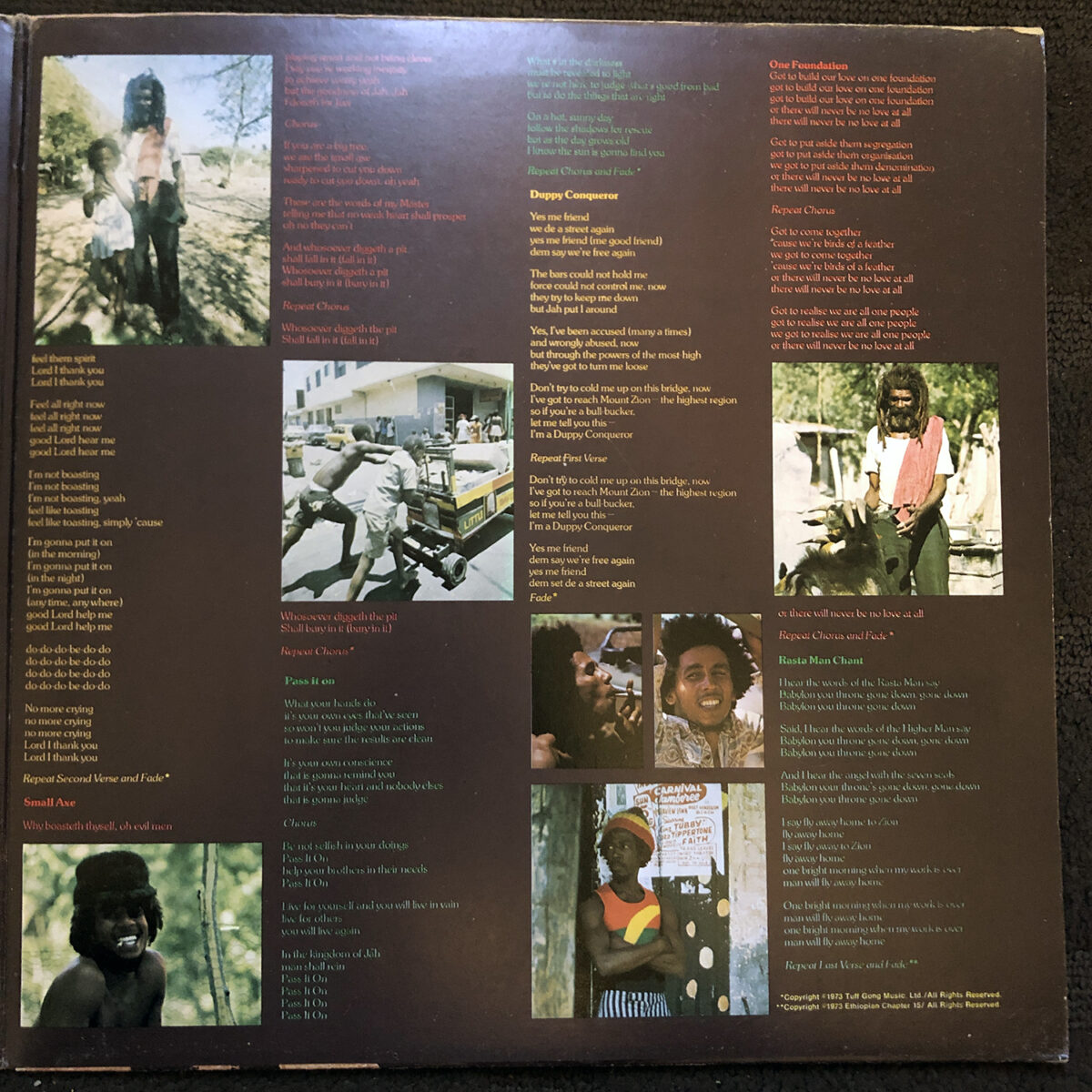
Such songs illuminated the desperation of poor Jamaican life, but they also looked forward to religious salvation, their themes accentuated by the compelling rhythms and the alternating vocals of the three singers. Here, on "Burnin' and Lootin'," they take issue with fellow Jamaican Jimmy Cliff's song of the previous year, "Many Rivers to Cross," asking impatiently, "How many rivers do we have to cross/Before we can talk to the boss?" "I Shot the Sheriff," the album's most celebrated song, which became a number one hit in the hands of Eric Clapton in 1974, claims self-defense, admits consequences ("If I am guilty I will pay"), and emphasizes the isolated nature of the killing ("I didn't shoot no deputy"), but its central image is violent. The Wailers are explicit in their call to violence, a complete reversal from their own 1960s "Simmer Down" philosophy. The confrontational nature of the group's message is apparent immediately in the opening track, "Get Up, Stand Up," as stirring a song as any that emerged from the American Civil Rights movement a decade before. But they fit in seamlessly with the newer material, matching its religious militancy and anthemic style. Given that speed, it's not surprising that several tracks - "Put It On," "Small Axe," and "Duppy Conqueror" - are re-recordings of songs dating back a few years. While none of the aforementioned songs was anything approaching a hit in the United States during Bob Marley’s lifetime, they constitute a legacy that has only increased his fame in the years since his death on this day in 1981.The Wailers' fourth album overall, Burnin', was their second for Island Records, released only six months after its predecessor, Catch a Fire. With the departure of Tosh and Wailer in 1974, Marley took center stage in the group, and by the late 70s he had turned out a string of albums- Exodus (1977), featuring “Jamming,” “Waiting In Vain” and “One Love/People Get Ready ” Kaya (1978), featuring “Is This Love” and “Sun Is Shining” and Uprising (1980), featuring “Could You Be Loved” and “Redemption Song.” Eric Clapton spread the group’s name even wider by recording a pop-friendly version of “I Shot The Sheriff” from the latter album. Thanks to the international reach of Island Records, the Wailers came to the world’s attention in the early 1970s via their albums Catch a Fire (1972) and Burnin’ (1973). From a mix of New Orleans-style rhythm and blues and indigenous, African-influenced musical traditions arose first ska, then rock steady-precursor styles to reggae, which did not take shape as a recognizable style of its own until the late 1960s.īob Marley, Peter Tosh and Bunny Wailer performed together as The Wailers throughout this period, coming into their own as a group just as reggae became the dominant sound in Jamaica. As transistor radios became available on an island then served only by a staid, BBC-style national radio station, the music of America suddenly became accessible via stateside radio stations.

Jamaica at the time was entering a period of incredible musical creativity. At the age of nine, Marley moved to Trench Town, a tough West Kingston ghetto where he would meet and befriend Neville “Bunny” Livingston (later Bunny Wailer) and Peter McIntosh (later Peter Tosh) and drop out of school at age 14 to make music. Ann Parish, Jamaica, the son of a middle-aged white Jamaican Marine officer and an 18-year-old Black Jamaican girl. Nesta Robert Marley was born on February 6, 1945, in rural St. Less than eight months later, on May 11, 1981, Bob Marley, the soul and international face of reggae music, died in a Miami, Florida, hospital.

Marley’s intense singing and electric stage presence, the Commodores were a letdown.” Only days after his triumphant shows in New York City, Bob Marley collapsed while jogging in Central Park and later received a grim diagnosis: a cancerous growth on an old soccer injury on his big toe had metastasized and spread to Marley’s brain, liver and lungs. With no costumes, no choreography and no set design to speak of, “The reggae star had the majority of his listeners on their feet and in the palm of his hand,” according to New York Times critic Robert Palmer. In what would prove to be the next to the last concert of his tragically short life, Bob Marley shared the bill at Madison Square Garden with the hugely popular American funk band The Commodores.


 0 kommentar(er)
0 kommentar(er)
